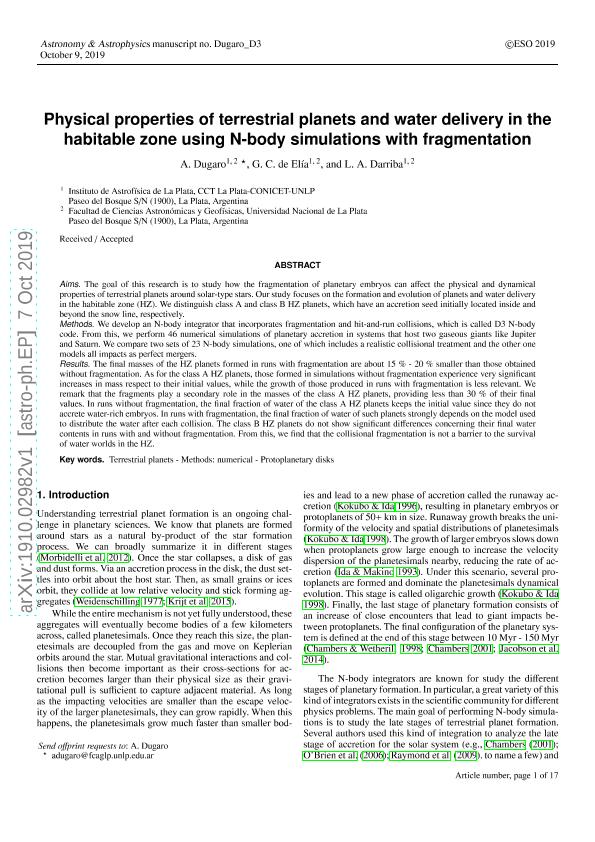Mostrar el registro sencillo del ítem
dc.contributor.author
Dugaro, Agustin

dc.contributor.author
Elías, Gabriela del Valle

dc.contributor.author
Darriba, Luciano Ariel

dc.date.available
2021-12-09T13:26:29Z
dc.date.issued
2019-11-13
dc.identifier.citation
Dugaro, Agustin; Elías, Gabriela del Valle; Darriba, Luciano Ariel; Physical properties of terrestrial planets and water delivery in the habitable zone using N-body simulations with fragmentation; EDP Sciences; Astronomy and Astrophysics; 632; A14; 13-11-2019; 1-17
dc.identifier.issn
0004-6361
dc.identifier.uri
http://hdl.handle.net/11336/148478
dc.description.abstract
The goal of this research is to study how the fragmentation of planetary embryos can affect the physical and dynamical properties of terrestrial planets around solar-type stars. Our work focuses on the formation and evolution of planets and water delivery in the Habitable Zone. We distinguish class A and class B HZ planets, which have an accretion seed initially located inside and beyond the snowline, respectively. We develop an Nbody integrator that incorporates fragmentation and hit-and-run collisions, which is called D3 N-body code. From this, we perform 46 numerical simulations of planetary accretion in systems that host two gaseous giants like Jupiter and Saturn. We compare two sets of 23 N-body simulations, one of which includes a realistic collisional treatment and the other one models all impacts as perfect mergers. The final masses of the HZ planets formed in runs with fragmentation are about 15%-20% smaller than those obtained without fragmentation. As for the class A HZ planets, those formed in simulations without fragmentation experience very significant increases in mass respect to their initial values, while the growth of those produced in runs with fragmentation is less relevant. We remark that the fragments play a secondary role in the masses of the class A HZ planets, providing less than 30% of their final values. In runs without fragmentation, the final fraction of water of the class A HZ planets keeps the initial value since they do not accrete water-rich embryos. In runs with fragmentation, the final fraction of water of such planets strongly depends on the model used to distribute the water after each collision. The class B HZ planets do not show significant differences concerning their final water contents in runs with and without fragmentation. From this, we find that the collisional fragmentation is not a barrier to the survival of water worlds in the HZ.
dc.format
application/pdf
dc.language.iso
eng
dc.publisher
EDP Sciences

dc.rights
info:eu-repo/semantics/openAccess
dc.rights.uri
https://creativecommons.org/licenses/by/2.5/ar/
dc.subject
TERRESTRIAL PLANETS
dc.subject
METHODS: NUMERICAL
dc.subject
PROTOPLANETARY DISKS
dc.subject.classification
Astronomía

dc.subject.classification
Ciencias Físicas

dc.subject.classification
CIENCIAS NATURALES Y EXACTAS

dc.title
Physical properties of terrestrial planets and water delivery in the habitable zone using N-body simulations with fragmentation
dc.type
info:eu-repo/semantics/article
dc.type
info:ar-repo/semantics/artículo
dc.type
info:eu-repo/semantics/publishedVersion
dc.date.updated
2020-11-19T21:56:58Z
dc.journal.volume
632
dc.journal.number
A14
dc.journal.pagination
1-17
dc.journal.pais
Francia

dc.journal.ciudad
París
dc.description.fil
Fil: Dugaro, Agustin. Consejo Nacional de Investigaciones Científicas y Técnicas. Centro Científico Tecnológico Conicet - La Plata. Instituto de Astrofísica La Plata. Universidad Nacional de La Plata. Facultad de Ciencias Astronómicas y Geofísicas. Instituto de Astrofísica La Plata; Argentina
dc.description.fil
Fil: Elías, Gabriela del Valle. Consejo Nacional de Investigaciones Científicas y Técnicas. Centro Científico Tecnológico Conicet - La Plata. Instituto de Astrofísica La Plata. Universidad Nacional de La Plata. Facultad de Ciencias Astronómicas y Geofísicas. Instituto de Astrofísica La Plata; Argentina
dc.description.fil
Fil: Darriba, Luciano Ariel. Consejo Nacional de Investigaciones Científicas y Técnicas. Centro Científico Tecnológico Conicet - La Plata. Instituto de Astrofísica La Plata. Universidad Nacional de La Plata. Facultad de Ciencias Astronómicas y Geofísicas. Instituto de Astrofísica La Plata; Argentina
dc.journal.title
Astronomy and Astrophysics

dc.relation.alternativeid
info:eu-repo/semantics/altIdentifier/arxiv/https://arxiv.org/abs/1910.02982
dc.relation.alternativeid
info:eu-repo/semantics/altIdentifier/doi/http://dx.doi.org/ 10.1051/0004-6361/201936061
Archivos asociados
